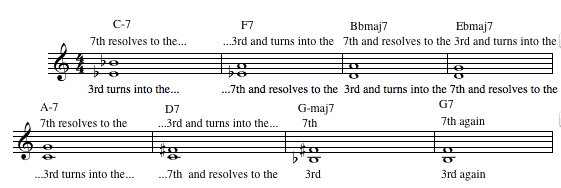Guide Tones
Guide tones are an excellent way to study and absorb the sound of a chord progression. Guide tones are typically considered to be the 3rd and 7th scale degree of a chord because this is what determines whether a chord is major, minor, or dominant. Guide tones get to the center or essence of a chord progression and how it sounds moving from one chord to the next. Here are the guide tones for Autumn Leaves:

The 3rd degree is the most stable sounding note and the 7th degree sounds the most unstable. This is the reason you find many melodic lines that move from the 7th of a chord to the 3rd of the next chord in order to outline this tension and release.
There are also guide tone lines which are step-wise lines (whole steps or half steps) that travel through a chord progression and often consist of the 3rds and 7ths, but can sometimes also be 5ths, 6ths, and 9ths. Many songs have lots of possible guide tone lines and often the melody or an improvisation will focus around these moving lines. Here's a possible ascending guide tone line for Autumn Leaves:

It's good to learn the 3rd and seventh guide tones of a progression as well as other possible guide tone lines. This will really get the "sound" of a progression in your ear. Some bebop melodies will juggle multiple guide tone lines n the same phrase and sound very complex but nice.
Go back to Jazz Theory or return to The Jazz Resource Homepage